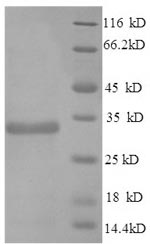The production of this Recombinant Mouse Apoe protein required the insertion of a DNA fragment (Apoe, 19-311aa) into a plasmid vector and the transferral of this vector into Yeast cells (the step of transformation). The cells were then cultured and induced to express the Apoe protein. This recombinant protein was fused with N-terminal 6xHis tag. Its purity is 90%+ determined by SDS-PAGE.
Apoe is a gene providing an instruction of making a protein named apolipoprotein E (Apo-E) in mus musculus (mouse). This gene has many orthologs in multiple mammals, such as human, norway rat, pig, cattle, etc. Apo-E protein belongs to a family of fat-binding proteins called apolipoproteins, which combines with fats (lipids) in the body to form molecules called lipoproteins. Increasing studies has demonstrated that apoE-deficient mice exhibit neuronal abnormalities similar to those in Alzheimer's disease and enhanced sensitivity to stroke-associated injuries.






